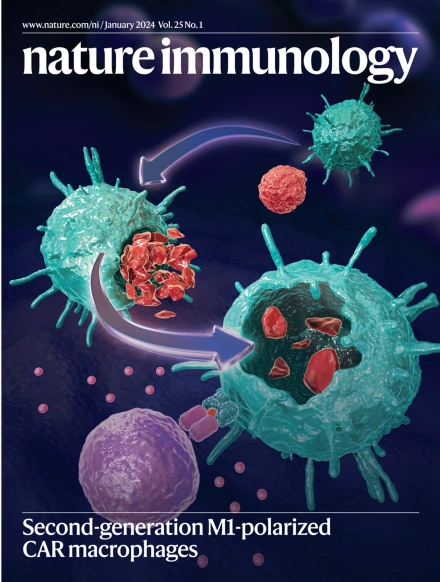Tuft cell IL-17RB restrains IL-25 bioavailability and reveals context-dependent ILC2 hypoproliferation
IF 27.7
1区 医学
Q1 IMMUNOLOGY
引用次数: 0
Abstract
The tuft cell–group 2 innate lymphoid cell (ILC2) circuit orchestrates rapid type 2 responses upon detecting microbially derived succinate and luminal helminths. Our findings delineate key mechanistic steps involving IP3R2 engagement and Ca2+ flux, governing interleukin-25 (IL-25) production by tuft cells triggered by succinate detection. While IL-17RB has a pivotal intrinsic role in ILC2 activation, it exerts a regulatory function in tuft cells. Tuft cells exhibit constitutive Il25 expression, placing them in an anticipatory state that facilitates rapid production of IL-25 protein for ILC2 activation. Tuft cell IL-17RB is crucial for restraining IL-25 bioavailability, preventing excessive tonic ILC2 stimulation due to basal Il25 expression. Supraoptimal ILC2 stimulation by IL-25 resulting from tuft cell Il17rb deficiency or prolonged succinate exposure induces a state of hypoproliferation in ILC2s, also observed in chronic helminth infection. Our study offers critical insights into the regulatory dynamics of IL-25 in this circuit, highlighting the delicate tuning required for responses to diverse luminal states. Tuft cells constitutively express IL-25 to sustain ILC2 homeostasis in the intestine, but mechanisms driving IL-25 secretion have been unclear. Here, Feng et al. find that tuft cells express IL-17RB, which is required to regulate the bioavailability of IL-25 and to restrain the activation of ILC2s during homeostasis.


簇状细胞IL-17RB抑制IL-25的生物利用度,揭示了环境依赖性ILC2的低增殖
簇状细胞- 2组先天淋巴样细胞(ILC2)回路在检测微生物来源的琥珀酸和管腔蠕虫时协调快速的2型反应。我们的研究结果描绘了关键的机制步骤,涉及IP3R2接合和Ca2+通量,控制由琥珀酸检测触发的簇状细胞产生白细胞介素-25 (IL-25)。虽然IL-17RB在ILC2激活中具有关键的内在作用,但它在簇状细胞中发挥调节功能。簇状细胞表现出组成性Il25表达,使它们处于预期状态,促进IL-25蛋白的快速产生,从而激活ILC2。簇状细胞IL-17RB对于抑制IL-25的生物利用度,防止Il25基础表达引起的过度补性ILC2刺激至关重要。簇状细胞Il17rb缺乏或长时间琥珀酸暴露导致IL-25对ILC2的超优化刺激可诱导ILC2s的低增殖状态,这在慢性蠕虫感染中也观察到。我们的研究为IL-25在该回路中的调控动力学提供了重要的见解,强调了对不同腔态响应所需的微妙调节。
本文章由计算机程序翻译,如有差异,请以英文原文为准。
求助全文
约1分钟内获得全文
求助全文
来源期刊

Nature Immunology
医学-免疫学
CiteScore
40.00
自引率
2.30%
发文量
248
审稿时长
4-8 weeks
期刊介绍:
Nature Immunology is a monthly journal that publishes the highest quality research in all areas of immunology. The editorial decisions are made by a team of full-time professional editors. The journal prioritizes work that provides translational and/or fundamental insight into the workings of the immune system. It covers a wide range of topics including innate immunity and inflammation, development, immune receptors, signaling and apoptosis, antigen presentation, gene regulation and recombination, cellular and systemic immunity, vaccines, immune tolerance, autoimmunity, tumor immunology, and microbial immunopathology. In addition to publishing significant original research, Nature Immunology also includes comments, News and Views, research highlights, matters arising from readers, and reviews of the literature. The journal serves as a major conduit of top-quality information for the immunology community.
 求助内容:
求助内容: 应助结果提醒方式:
应助结果提醒方式:


